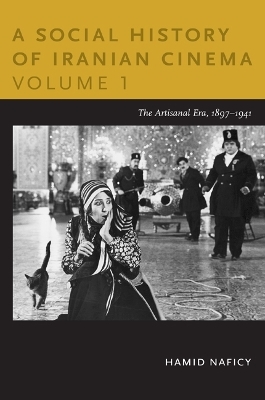
A Social History of Iranian Cinema, Volume 1
Duke University Press (Verlag)
978-0-8223-4775-0 (ISBN)
Hamid Naficy is one of the world’s leading authorities on Iranian film, and A Social History of Iranian Cinema is his magnum opus. Covering the late nineteenth century to the early twenty-first and addressing documentaries, popular genres, and art films, it explains Iran’s peculiar cinematic production modes, as well as the role of cinema and media in shaping modernity and a modern national identity in Iran. This comprehensive social history unfolds across four volumes, each of which can be appreciated on its own. Volume 1 depicts and analyzes the early years of Iranian cinema. Film was introduced in Iran in 1900, three years after the country’s first commercial film exhibitor saw the new medium in Great Britain. An artisanal cinema industry sponsored by the ruling shahs and other elites soon emerged. The presence of women, both on the screen and in movie houses, proved controversial until 1925, when Reza Shah Pahlavi dissolved the Qajar dynasty. Ruling until 1941, Reza Shah implemented a Westernization program intended to unite, modernize, and secularize his multicultural, multilingual, and multiethnic country. Cinematic representations of a fast-modernizing Iran were encouraged, the veil was outlawed, and dandies flourished. At the same time, photography, movie production, and movie houses were tightly controlled. Film production ultimately proved marginal to state formation. Only four silent feature films were produced in Iran; of the five Persian-language sound features shown in the country before 1941, four were made by an Iranian expatriate in India.
A Social History of Iranian Cinema
Volume 1: The Artisanal Era, 1897–1941
Volume 2: The Industrializing Years, 1941–1978
Volume 3: The Islamicate Period, 1978–1984
Volume 4: The Globalizing Era, 1984–2010
Hamid Naficy is Professor of Radio-Television-Film and the Hamad Bin Khalifa Al-Thani Professor in Communication at Northwestern University. He is the author of An Accented Cinema: Exilic and Diasporic Filmmaking, The Making of Exile Cultures: Iranian Television in Los Angeles, and (in Persian) Film-e Mostanad, a two-volume history of nonfiction cinema around the world. Naficy helped to launch ongoing annual Iranian film festivals in Los Angeles and Houston.
List of Illustrations ix
Acknowledgments xiii
Organization of the Volumes xxi
A Word about Illustrations xxvii
Preface. How It All Began xxix
Introduction. National Cinema, Modernity, and Iranian National Identity 1
1. Artisanal Silent Cinema in the Qajar Period 27
2. Ideological and Spectatorial Formations 71
3. State Formation and Nonfiction Cinema: Syncretic Westernization during the First Pahlavi Period 141
4. A Transitional Cinema: The Feature Film Industry and Sound Cinema 197
5. Modernity's Ambivalent Subjectivity: Dandies and the Dandy Movie Genre 277
Notes 309
Bibliography 343
Index 371
| Zusatzinfo | 74 illustrations, 1 table |
|---|---|
| Verlagsort | North Carolina |
| Sprache | englisch |
| Maße | 156 x 235 mm |
| Gewicht | 630 g |
| Themenwelt | Kunst / Musik / Theater ► Film / TV |
| Geisteswissenschaften ► Geschichte ► Regional- / Ländergeschichte | |
| Geschichte ► Teilgebiete der Geschichte ► Kulturgeschichte | |
| Geschichte ► Teilgebiete der Geschichte ► Sozialgeschichte | |
| ISBN-10 | 0-8223-4775-X / 082234775X |
| ISBN-13 | 978-0-8223-4775-0 / 9780822347750 |
| Zustand | Neuware |
| Haben Sie eine Frage zum Produkt? |
aus dem Bereich


